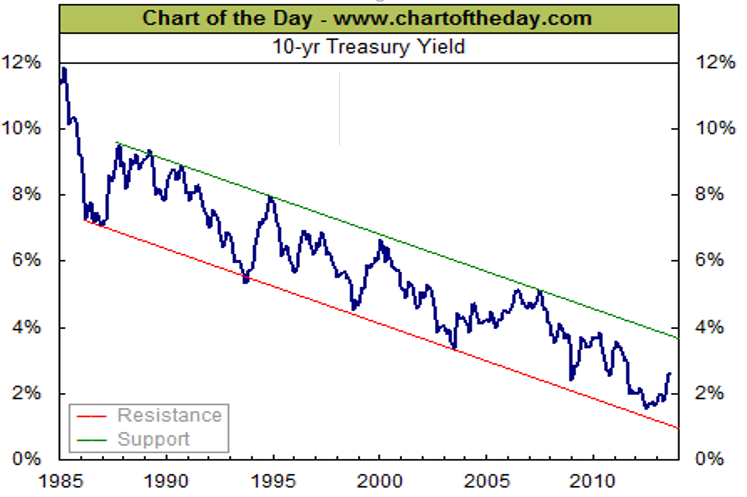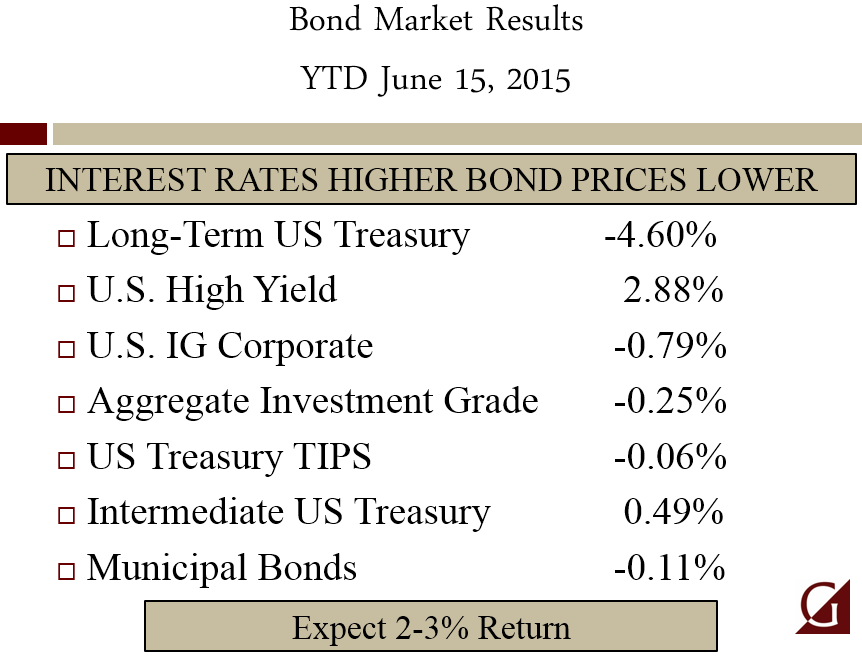Q2 2015 – Market and Economic Review
Mid-Year 2015
Time quickly marches on. With the calendar year halfway behind us, it’s a great time to review the known and to anticipate the unknown. Entering 2015, we had a basic set of expectations for the new year. We predicted stocks to generate single digit returns in the low to mid range for the full year and bonds would deliver low single digit returns. We are now at the midway point, and these annual expectations are still realistic.
Due to a variety of factors, both the U.S. and global stock markets ran into some near-term obstacles. As global interest rates rose and the U.S dollar strengthened, corporate profits grew marginally, which created a cautious atmosphere in the financial markets. June’s price declines and higher price volatility can be attributed to Greece’s financial woes and ultimate bond default.
In the U.S., stock valuations are now a bit stretched as the forward 12-month price-to-earnings (PE) ratio for the S&P 500 companies is 17 times. This is above both the five and ten year historical PE averages. Simply stated, the stock market needs to buy time until better future earnings can support these valuations. International stocks may well be setting up for future outperformance as foreign central banks are implementing a U.S. style easing program, but country specific financial stress could postpone a rally. The remainder of 2015 may very well be about getting to 2016. In 2016, the year over year comparisons will become more market friendly as both the increasing dollar and the declining price of oil will have been over a year in the making.
In the U.S. bond market, the mantra has been a call to higher interest rates. While the Federal Reserve has opted to stay the course for now, the market took it upon itself to allow longer term interest rates to rise. For the calendar year, the short end of the yield curve is unchanged and longer maturity rates have moved marginally higher. The 10-year U.S. Treasury climbed 23 basis points to yield 2.35 percent and the 30-year is up 42 basis point to yield 3.11 percent.
The Federal Reserve would love to return to a normal monetary policy but the Fed needs stronger economic data to support future rate increases. The data is moving in the Fed’s direction, but is not yet strong enough to invoke a rate hike. While the much anticipate June rate increase did not happen, September or December is ripe for one 25 basis point hike in the federal funds rate. The eventual rate hike will likely be a symbolic move whereby the Fed can state they ended their zero rate interest policy and have returned to a normal monetary stance. Unless the global economic data really heats up, the Fed’s first rate hike may be a “one and done” for a while.
At the end of the day, investors need to be invested. With cash yields frozen at zero, your choices are to either sit on the sidelines with inflation quietly eroding your purchasing power or to invest with a long-term purpose. Being a long-term investor with realistic expectations is the right answer. Bond yields are low and likely to stay there so expect annual returns in the two to three percent area. Stocks offer long-term growth opportunities, but given current valuations expect mid to low single digit returns as we move toward the end of this year. Keep your portfolio invested within your comfort zone and stay two steps ahead of inflation.
MARKET BY NUMBERS:
The Fed Says……
The June 2015 Federal Reserve Open Market Committee (FOMC) meeting was highly anticipated. This meeting was earmarked six to nine months ago as the meeting where the Fed would likely end their six-year zero interest rate policy and raise the fed funds rate. Well, the meeting is over and the Fed still has not raised rates. Now the debate will focus on if the September or December FOMC meetings will be when they finally raise rates.
What did the Fed say and what does it mean for interest rates and the bond market? The Fed said:
- Economic activity has been expanding moderately after little change in the first quarter
- The pace of job gains picked up
- The unemployment rate remained steady
- Underutilization of labor resources diminished somewhat
- Future economic activity will expand at a moderate pace
- Inflation will remain near its recent low level over the short term with a gradual rise to 2%.
This scenario of moderate growth and low inflation is positive for both stocks and bonds. The bond market has been bracing for the Fed to increase the fed funds rates by 25 basis points for at least six months, and it may take another six months for them to act. The Fed is clear that their future actions will be data dependent (specifically in relation to the employment and inflation figures). The Fed wants economic strength to support a rate hike so they can exit their zero interest rate policy (ZIRP) and normalize interest rates.
While the financial media is hyping Armageddon in the bond market, we’re not ready to throw in the towel on bonds just yet. The Fed will likely institute a symbolic 25 basis points rate hike prior to year end, but it will not change the fundamentals affecting bonds. Slow growth with low inflation is not a recipe for runaway interest rates. Moreover, the following metrics should keep interest rates low for an extended period of time:
- Weak global demand
- Weak commodity markets
- An aging demographic
- Central banks in an accommodative mode across the globe
It’s been a generational bull market in bonds and ending it will take an old-fashioned recovery of at least 4-5% GDP growth coupled with full employment. The chart below tells me the bull market in bonds is still alive.
Until interest rates on the 10-year Treasury bond break above its downward trending channel, we’re not worried about major losses in the bond market. Going forward however, we do need to temper our return expectations in bonds. Bond prices rise as interest rates fall; so as rates have moved from 8% to 6% to 4% to 2% there is little room left for capital appreciation. Expectations for future bond returns need to be tied closely to the interest earned (coupons). Expect 2-3% returns from bonds moving forward, not the 5-6% from days gone by.
Through June 15 of this year, returns from the various sectors of the bond market have been relatively flat despite the recent increase in interest rates.
Bonds still have a place in one’s portfolio, but they need to have a clear purpose/objective behind them such as:
- Using a bond ladder to help provide for future cash flow needs
- Helping to diversify risk away from stocks and controlling overall portfolio risk
- Provide a small income in the current environment
- Providing necessary liquidity
The key to owning bonds is to combine the appropriate return expectations with a proper fixed income allocation that matches your investment objectives.
As of June 18th, 2015:
Dow Jones US Moderately Conservative Index is up 2.05% (TR) for the year
S&P 500 closed at 2,121 up 4.03% for the year
Russell 2000 closed at 1,284 up 7.24% for the year
U.S. 10 year Treasury Futures are yielding 2.35% up 0.18% for the year
WTI Crude Oil futures closed at $60.82 up $7 for the year
Gold closed at $1,202 per ounce up $19 for the year
To expand on these market reflections or discuss other portfolio strategies please don’t hesitate to reach out to us at 775-674-2222.



